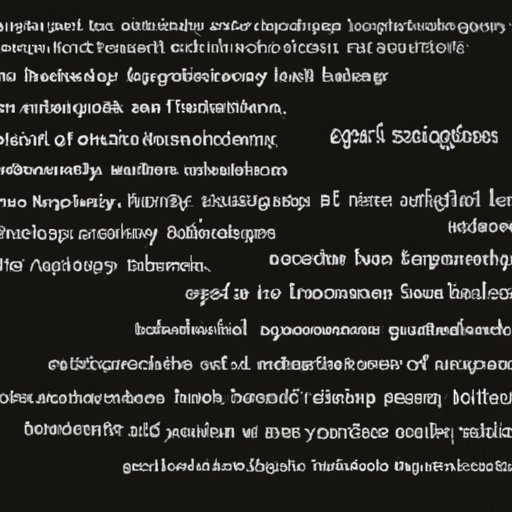Introduction
Style in literature is the way that an author chooses to express his or her ideas through the use of language. It is a key element in literary analysis, as it helps to convey the author’s message and meaning to the reader. The style of a piece of literature can be determined by examining the language used, the structure of the work, and the tone and imagery employed. In this article, we will explore the role of style in literary analysis, the different types of literary styles, the connection between language and style, the impact of literary style on the reader’s understanding, the impact of literary style on genres, and the relationship between style and theme.
Definition of Style in Literature
Style in literature is defined as “the manner in which something is written, as opposed to its content” (Oxford Reference). It is a combination of elements, such as diction, syntax, figurative language, imagery, and tone, that give a writer’s work its unique feel and flavor. A writer’s style reflects his or her individual writing voice, which is shaped by experience, education, and cultural influences. By studying the style of a particular writer, readers can gain insight into the author’s thoughts, feelings, and intentions.

Overview of the Role of Style in Literary Analysis
In literary analysis, style is often used to distinguish different authors and their works. For example, the style of Ernest Hemingway’s writing is distinctively different from that of William Faulkner. In addition, style can be used to examine the development of an author’s work over time. For instance, the style of J.D. Salinger’s early works differs from that of his later works. Style can also be used to compare two works of similar themes or topics. For example, the styles of two novels about war may differ significantly despite having similar themes.
Types of Literary Styles
Literary styles can be divided into three main categories: prose, poetry, and drama. Prose is the most common type of literary style and consists of stories, novels, and essays. It is written in sentences and paragraphs, and usually follows a linear structure. Poetry is a type of literature that consists of verse, usually composed of rhyming lines. Drama is a form of literature that is performed on stage or screen. It is typically written in dialogue and includes characters, settings, and plot.

Connection between Language and Style
The connection between language and style is essential for any writer. Language is the medium through which writers communicate their ideas, and the choices they make when using language help to shape the style of their work. The use of syntax, choice of words, and use of figurative language are all important aspects of language that affect the style of a piece of literature. Syntax refers to the arrangement of words and phrases in a sentence, and how these arrangements create meaning. Choice of words involves selecting specific words and phrases to convey an idea or emotion. Figurative language uses words and phrases to create vivid images and evoke strong emotions in the reader.
Impact of Literary Style on Reader’s Understanding
The style of a piece of literature can have a significant impact on the reader’s understanding and enjoyment of the work. One way style affects the reader is through the tone of the work. Tone is the attitude of the author towards the subject matter and the audience. It can range from serious and formal to lighthearted and humorous. Tone can influence the reader’s perception of the work, and can even affect the reader’s emotional response to the text. Another way literary style affects the reader is through the use of imagery. Imagery is the use of descriptive language to create a vivid mental image of the subject matter. Through the use of imagery, the author can draw the reader into the story and evoke strong emotions in the reader.
Impact of Literary Style on Genres
The style of a piece of literature can also have an impact on the genre of the work. Different genres require different styles, and the style of a work can help determine which genre it belongs to. For example, a romance novel typically has a light and airy style, while a horror novel will usually have a darker, foreboding style. Similarly, a comedy will usually employ a humorous style, while a tragedy will typically have a more serious and somber tone. All of these genres rely on the use of language and style to convey the desired mood and atmosphere.

Relationship between Style and Theme
The relationship between style and theme is an important one in literature. Style and theme are closely intertwined, as the style of a work can be used to convey its underlying theme. For example, the use of symbolism is a common way of conveying a theme in literature. Symbols are objects, people, or events that stand for something beyond themselves. By using symbols in his or her work, an author can subtly suggest a deeper meaning or theme. Metaphors and irony are other tools that authors use to express a theme through style. Metaphors compare two unlike things to illustrate a point, while irony is the use of language to convey the opposite of what is actually meant.
Conclusion
Style is an integral part of literature, as it helps to convey an author’s message and meaning to the reader. In literary analysis, style is used to distinguish different authors and their works, examine the development of an author’s work over time, and compare two works of similar themes or topics. There are three main types of literary styles: prose, poetry, and drama. The style of a piece of literature is determined by the language used, the structure of the work, and the tone and imagery employed. The style of a work can have a significant impact on the reader’s understanding and enjoyment of the work, as well as on the genre of the work. Finally, the relationship between style and theme is an important one, as the style of a work can be used to convey its underlying theme.
(Note: Is this article not meeting your expectations? Do you have knowledge or insights to share? Unlock new opportunities and expand your reach by joining our authors team. Click Registration to join us and share your expertise with our readers.)
